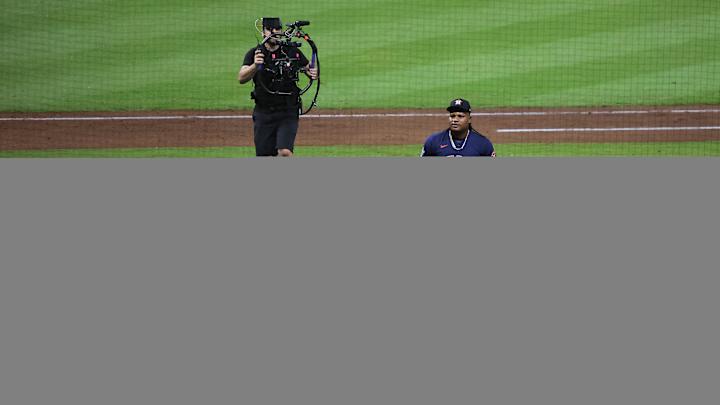How the Phillies Must Adjust To Beat Framber Valdez

In this story:
The Philadelphia Phillies are on their last legs. Down three games to two, they no longer have room for error in the World Series.
The next challenge the Houston Astros will throw their way is Framber Valdez, who utterly dominated Philadelphia in Game 2. He was equally terrific the last time he faced the Phillies, shutting them out over five innings on the last day of the regular season. On Saturday night, the lineup must figure out a way to beat Valdez in order to keep their World Series dreams alive.
The problem against Valdez is pretty clear: strikeouts. In his two starts opposite Philadelphia this season, Valdez punched out a total of 19 batters. That's more than half the outs he recorded. The Phillies managed to reach base against him several times in Game 2, earning a baserunner in six of the seven innings he pitched, but Valdez struck out the next batter almost every time. It's hard to get a rally going when you're not putting the ball in the play.
The solution to the Valdez problem is just as clear: the Phillies need to stop chasing his curveball and start swinging at his sinker. They have swung at 53% of his curves and 41% of his sinkers. Yet only 38% of his curveballs have been in the strike zone, while 60% of his sinkers have been in the box.
When they do swing against his sinker, they tend to make contact. The Phillies put 36% of the sinkers they swung at into play, compared to just 5% of the curveballs. In other words, the lineup is missing opportunities by swinging at the wrong pitches.
Thus, Valdez has gotten the Phillies to swing and miss at 18 curveballs, and he has earned an incredible 23 called strikes with his sinker. So I repeat: the Phillies need to stop chasing his curveball and start swinging at his sinker.
The problem is plain to see and the solution is right there in front of us. Execution, however, is going to be the hard part. Evidently, Philadelphia’s hitters are having a tough time seeing Valdez's pitches. And unfortunately, there's no easy solution here. Framber Valdez is a good pitcher, and he can pepper his pitches all over the inside and outside of the zone.
If there's one thing the Phillies' offense should look out for, though, it's his release point. Valdez seems to let go of his sinker a little higher than his curveball. Accordingly, he also releases his curve with his arm slightly further to his left. Take a look at these videos from Game 2. The first one, a swinging strike, is a curveball, while the second, a called strike, is a sinker.
It's not a huge difference, but it's certainly visible. And the data backs it up too. During his two starts against Philadelphia, Valdez released his sinker about an inch and a half higher than his curveball, and his curveball nearly two inches further to the left than his sinker (per Statcast). If the Phillies hitters can catch onto this distinction between the two pitches and make their swing decisions accordingly, it could help them to avoid strikeouts and put more balls in play.
More From SI's Inside The Phillies:
- Phillies Star Bryce Harper Doesn't Hold Back on Thoughts About Joe Girardi
- How Mike Trout Will Join the Phillies
- Could Bryce Harper's Favorite MLB Player Join the Philadelphia Phillies Next Season?
- Why You Should Root for the Philadelphia Phillies to Lose a Few Games
- Phillies Release 2023 Regular Season Schedule
- Have the Philadelphia Phillies Found Their Centerfielder of the Future?
- Could The Phillies Soon Be Playing in Wawa Park?
- How did Philadelphia end up with Citizens Bank Park?
- How the Phillie Phanatic Came to be America's Favorite Sports Mascot
- Picking the Phillies' All-Time Single Season Lineup
Make sure to follow Inside the Phillies on Substack and Twitter!

Leo Morgenstern is a writer and editor for Inside the Phillies. He also writes for FanGraphs and Just Baseball, and his work has appeared on Pitcher List and Baseball Prospectus. He previously covered the Phillies for SB Nation's The Good Phight. You can follow him on Twitter @morgensternmlb.